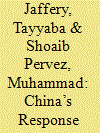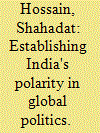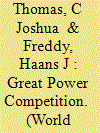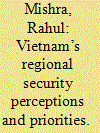|
|
|
Sort Order |
|
|
|
Items / Page
|
|
|
|
|
|
|
| Srl | Item |
| 1 |
ID:
193573


|
|
|
|
|
| Summary/Abstract |
In response to China’s phenomenal rise in the Indo-Pacific, the United States and its allies have institutionalized the QUAD. This article seeks to critique the novel construct of ‘Harmonious Realism’ and argues that the Chinese strategy for an Indo-Pacific regional order is paradoxical in nature. This paradox entails dichotomy between China’s rhetoric and practices in its institutional, strategic and economic aspects which can be empirically corroborated by the way China relates to ASEAN, its effort to seek an alternate model of security, and ensure economic interconnectivity through the BRI—all of which is counter-intuitive to China’s rhetoric of peaceful co-existence.
|
|
|
|
|
|
|
|
|
|
|
|
|
|
|
|
| 2 |
ID:
193246


|
|
|
|
|
| Summary/Abstract |
India’s foreign policy was historically rooted in movements like the Non-Aligned Movement (NAM), but currently, to counter China's rise in the Indo-Pacific region, India has joined a US-driven association, the Quadrilateral Security Dialogue (QUAD). India is also member of the Shanghai Cooperation Organization (SCO), which is a Eurasian bloc. Shahadat Hossain explores India's diplomatic balancing act by analysing its stance in the Ukraine-Russia conflict and its participation in the SCO and QUAD. He questions whether India merely balances or independently shapes international affairs. In balancing relationships with the SCO and QUAD, India demonstrates its diplomatic prowess and establishes a third pole, safeguarding its national interests.
|
|
|
|
|
|
|
|
|
|
|
|
|
|
|
|
| 3 |
ID:
193245


|
|
|
|
|
| Summary/Abstract |
The unequal distribution of power and resources has created conditions for conflict or even war between states. With the United States a declining hegemon and China on the rise, a conflict between these two great powers was bound to erupt. In this regard, the US government noted in the National Security Strategy of 2021 that China is a competitor and a threat to its goals and to its desire to remain the dominant power in the world. One of the factors that have brought China to the position of a challenge and competitor to the US and other powers is the Belt and Road Initiative (BRI). In this paper, C Joshua Thomas and Haans J Freddy throw some light on the great power competition in the context of BRI and examine how the US is leading the counterbalance with its Build Back Better World (B3W). The US and other liberal countries are challenging the BRI by means of the Quadrilateral Security Dialogue (QUAD) and the Free and Open Indo-Pacific (FOIP). What will be the consequences of such a great power competition and what challenges the BRI might face in the future are questions that this paper addresses
|
|
|
|
|
|
|
|
|
|
|
|
|
|
|
|
| 4 |
ID:
180084


|
|
|
|
|
| Summary/Abstract |
Over the past several decades, India and Vietnam have consolidated their relationship through bilateral engagements, which have been complemented by the Association of Southeast Asian Nations (ASEAN)-led multilateral mechanisms such as the East Asia Summit, ASEAN Regional Forum, ASEAN Defence Ministers’ Meeting Plus and the India-led Mekong–Ganga Cooperation (MGC). Building up on their traditionally strong relations, India and Vietnam have widened and deepened their defence and strategic links in recent years, which is manifested in joint trainings, military exercises and defence Lines of Credit offered by India. Since the 1990s, especially over the last decade, both India and Vietnam have made strategic readjustments to elevate their respective bilateral ties with like-minded countries bringing about new commonalities in their politico-strategic visions and policies. Like India, Vietnam too is trying to bring the multilateral and multi-dimensional Indo-Pacific agenda to the mainstream of its foreign policy calculations, facilitated by greater warmth in ties with Japan and the US. Vietnam’s embracing of the Indo-Pacific is also in sync with ASEAN’s Outlook on Indo-Pacific. It also aligns well with Vietnam’s long-standing policy of ‘Three Nos’, expanded to four in its 2019 Defence White Paper. While recent developments in the South China Sea have exacerbated Vietnam’s growing anxieties vis-à-vis China, considering its trade interlinkages and dependence on China (and Russia), it is apparent that Vietnam is not yet ready to uproot its multilayered linkages with China and get on board the ‘Quad Plus’ initiative that is perceived as an overtly anti-China coalition of democracies. India–Vietnam ties, therefore, must rely on the bilateral plank along with ASEAN-linked mechanisms, MGC and the Indo-Pacific construct while trying to develop concerted actions through deeper cooperation with Japan and the US. In short, any initiative to include Vietnam in a Quad Plus mechanism without sufficiently developing synergies with individual countries would not yield desired outcomes. This article argues that India–Vietnam ties would benefit most by attaching their bilateral pillar of relationship with the ASEAN- and Indo-Pacific-centred inclusive multilateral mechanisms while gradually engaging the US, Japan and other potential partners in suitable frameworks.
|
|
|
|
|
|
|
|
|
|
|
|
|
|
|
|
|
|
|
|
|